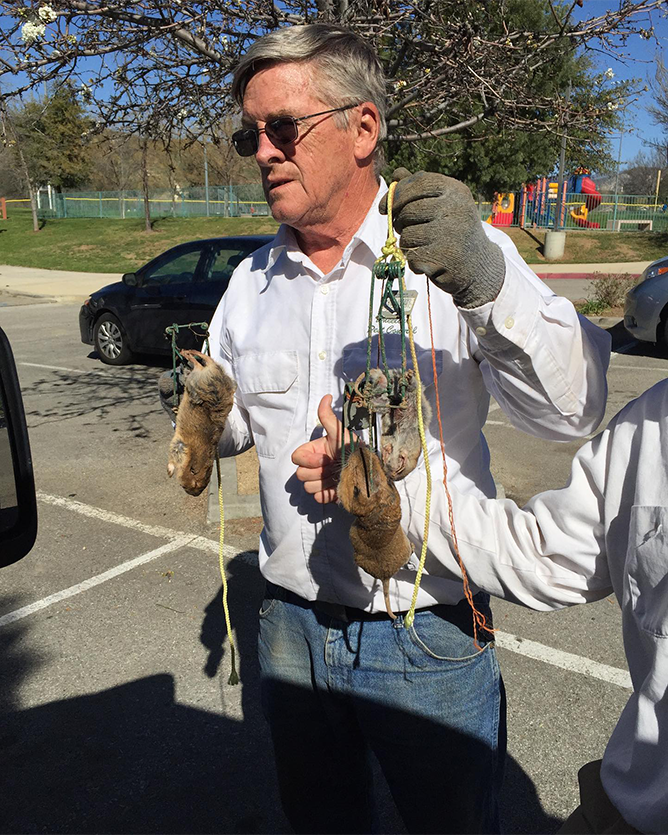Menu

Gophers are active all year-round. The best time to treat for gopher is the fall, winter and spring months, just after the fall breeding session and before they begin to reproduce in the spring.
Property owners who are plagued by gopher invasions on their properties need to stick with effective control measures if they want to minimize land damage.
Botta Pocket gophers are the most common gophers in Southern California, says Daniel Wheeler, Owner of Wheeler’s Pest Control. It ranges in size from 6 inches to 10 inches long, and is well-adapted to a burrowing and digging life. Fresh mounds of dirt on properties are the first sign of gopher activity. These pests are not often seen, remaining mostly underground in their burrow systems.
They are vegetarians and eat roots of most types of plants. They will gnaw on tree roots, tree trunks, irrigation lines. These hungry vertebrate pests will even girdle — and kill — vines and trees.
Properties adjacent to other properties where gophers are not controlled are likely to become infested over and over.
Gopher control is best done in Fall, Winter and Spring Gophers are active all year-round and breed in the spring and fall. The best time to go after gophers is the winter months, before they begin to reproduce in the spring and just after their fall breeding season. Also, the soil is usually much softer because of any rain that’s hit the property. January is a perfect time to begin a control program, he says, as mounds will be present to help identify active tunnel systems, the ground will be moist enough for easy probing. “You have to stay on top of the situation from the beginning,” Daniel says.
Methods of Control
Fumigation
On large properties, that are properties of at least 1 acre, Wheeler’s Pest Control uses three consecutive treatments with a aluminum phosphide fumigate. We have found this is the very best way at providing control. Using this product requires the applicator to send in a written notice to the County Agriculture Commissioners 24 hours before the application. It can’t be used within 100 feet of an occupied and/or a structure that may be occupied by people or animals. The property must be posted with signs which tells people that the fumigation is in process. But, just like a fumigation for a building which is tented for termites, you can use the gopher fumigant closer to buildings. The building has to be posted warning people to stay away and secured so people can’t get into that structure. The main gopher tunnel must be located with a probe, and the tablets dropped through the hole. Moisture in the tunnel activates the tablets to release the gas. The opening must be sealed tightly to keep light from entering as well as preventing any of the gas from leaking out.
Baiting
Toxic baits, including strychnine-treated grains, are also effective and can be used at 0.5 percent concentration in California. This is an acute product which the gopher can’t develop a resistance to. Daniel recommends using other control methods in rotation or in conjunction with each other to prevent resistance and get the best knock down.
Picture is of a product consumer might find/ this is not a professional grade product
Other materials such the anticoagulants you get at Home Depot and Lowes have not proven ineffective with gophers, because the animals don’t readily eat the baits used to deliver the ingredient. Unlike ground squirrels, gophers seldom ingest enough anticoagulant for a lethal dose. You see with the anticoagulants the gopher must eat the bait over a 7 to 10 period to get enough of the active ingredient to eliminate the gopher.
Trapping
Trapping is a safe and effective method for controlling pocket gophers on small properties. Several types and brands of gopher traps are available. The most common type is a two-pronged, pincher trap such as the Macabee, Cinch, or Gophinator, which the gopher triggers when it pushes against a flat, vertical pan.
To set traps you have to find the gophers main tunnel with a probe. Use a shovel or garden trowel to open the tunnel wide enough to set traps in pairs facing opposite directions. Placing traps with their openings facing in opposite directions means you will be able to intercept a gopher coming from either end of the burrow. This method is more time consuming than baiting.
It isn’t necessary to bait a gopher trap, although some claim baiting might give better results. You can use lettuce, carrots, apples, alfalfa greens, or peanut butter as bait. Wire your traps to stakes so you can easily retrieve them from the burrow. A trapped gopher that isn’t immediately killed by the trap can pull the trap deep into its burrows.
Check traps daily and reset when necessary. If you haven’t captured a gopher within 2 days, reset the traps in a different location.
Guys came on time did their job in a very professional way and we are very happy with their service.
Company is on top of their game David showed up to get are gophers. came out three days in a row haven’t seen a go for since
Joseph is a great ambassador for Wheeler's pest control, and a shout out to Daniel for dealing with my crazy schedule. Thanks guys!
A local business that everyone should support. All techs are knowledgeable, professional! FYI, they are also great w/ eradicating gophers as well!!